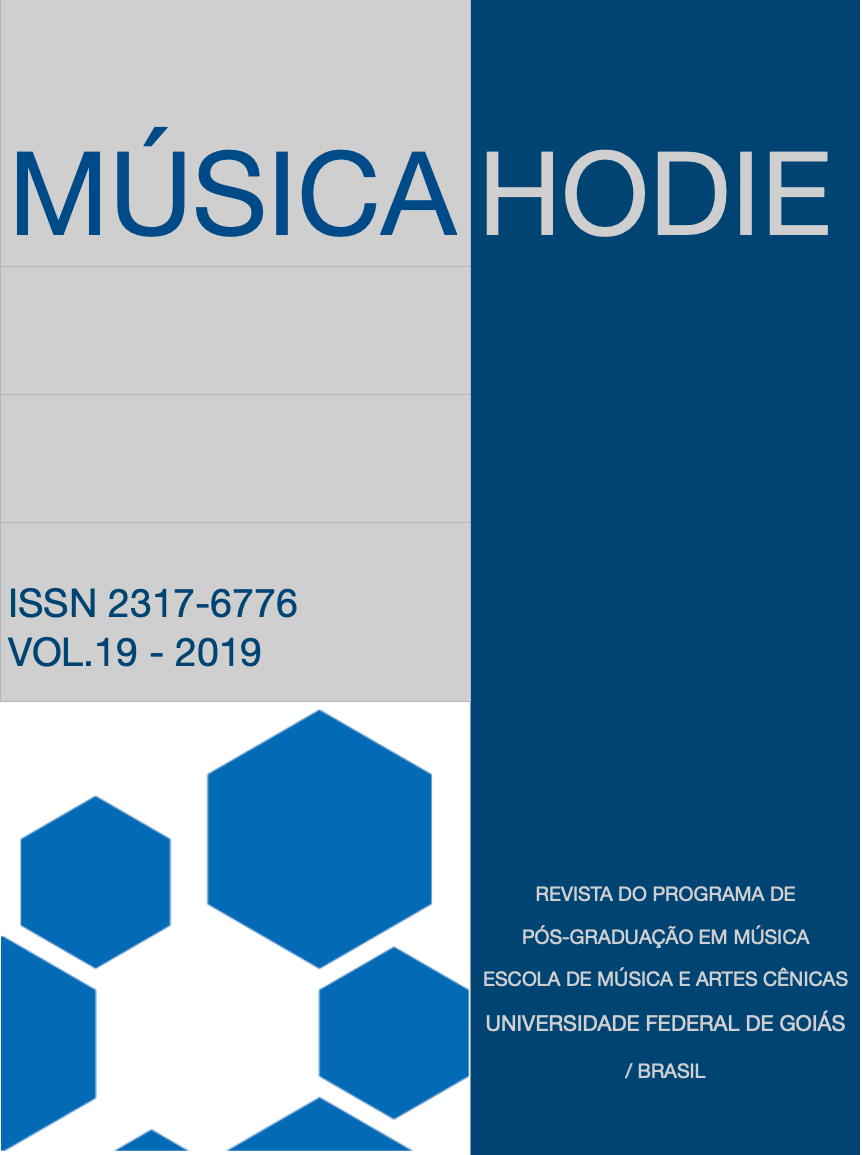Cross-sensory experiences and the enlightenment: music synesthesia in context
DOI:
https://doi.org/10.5216/mh.v19.54919Palavras-chave:
Music synesthesia. Enlightenment. Cross-sensory experiences. Multisensory experiences.Resumo
ABSTRACT: This study contemplates cross-sensory experiences as represented in late eighteenth-century thought, prior to George Sachs’s description of synesthesia in 1812. Sachs’s medical dissertation is now considered to be the first convincing scientific report of synesthesia in literature. Yet, less objective historical instances of cross-sensory experiences are not new to music, the visual arts, and poetry. Since these instances are difficult to assess on the part of modern disciplines (including musicology) due to their subjective nature, references to cross-sensory experiences prior to this date are either overlooked or simply ignored. The Medieval and Renaissance understandings of multisensory associations, deriving from natural science and cosmology, gradually gave way to rationalized discussions based on mathematics, physics, and practical experimentations as time elapsed. In eighteenth-century literature, allusions to sound-colour parallels enjoy special attention in the writings of Voltaire, Rousseau, Diderot, among others. In discussing the validity of these associations and their mechanisms, some authors extended these correspondences to other senses as well: touch, taste, and smell. This research is rooted in a historical survey of Enlightenment approaches to multisensory experiences—along with their priority for reason—discussing to which extent they are strictly ‘scientific,’ since the long eighteenth century still witnessed the coexistence of natural, cosmological, and philosophical readings of cross-sensory analogies. It also inquires whether Enlightenment thought established a philosophical foundation for initial investigations on music synesthesia. Finally, this study searches for a place for Sachs’s dissertation among Enlightenment debates—the philosophical and historical context that afforded its conception.
Downloads
Referências
ASHER, Julian E.; CARMICHAEL, Duncan A. The Genetics and Inheritance of Synesthesia. In: SIMNER, Julia; HUBBARD, Edward (Eds.). The Oxford Handbook of Synesthesia. Oxford: Oxford University Press, 2013. p. 23-45.
CASTEL, Louis-Bertrand. Clavecin pour les yeux, avec l’art de peindre les sons, et toutes sortes de pièces de musique. Mercure de France, p. 2552-2577, 1725.
CYTOWIC, Richard E.; EAGLEMAN, David M. Wednesday is Indigo Blue: Discovering the Brain of Synesthesia. Cambridge: MIT Press, 2009.
DOLAN, Emily I. The Orchestral Revolution: Haydn and the Technologies of Timbre. New York: Cambridge University Press, 2013.
FRANSSEN, Maarten. The Ocular Harpsichord of Louis-Bertrand Castel: The Science and Aesthetics of an Eighteenth-Century Cause Célèbre. Tractrix, v. 3, p. 15-77, 1991.
HANKINS, Thomas. The Ocular Harpsichord of Louis-Bertrand Castel; or, the Instrument that Wasn’t. Osiris, v. 9, p. 141-156, 1994.
JEWANSKI, Jörg; DAY, Sean A.; WARD, Jamie. A Colourful Albino: The First Documented Case of Synesthesia, by George Tobias Ludwig Sachs in 1812. Journal of the History of the Neurosciences, v. 18, n. 3, p. 293-303, 2009.
JEWANSKI, Jörg. Ist C=Rot?: eine Kultur- und Wissenschaftsgeschichte zum Problem der wechselseitigen Beziehung zwischen Ton und Farbe: von Aristoteles bis Goethe. [Sinzig]: Studio, 1999.
JEWANSKI, Jörg; SIDLER, Natalia; LASZLO, Alexander. Farbe, Licht, Musik: Synästhesie und Farblichtmusik. Bern: Peter Lang, 2006.
JEWANSKI, Jörg; SIDLER, Natalia (Eds.). Synesthesia in the Nineteenth Century: Scientific Origins. In: SIMNER, Julia; HUBBARD, Edward (Eds.). The Oxford Handbook of Synesthesia. Oxford: Oxford University Press, 2013. p. 369-398.
KRÜGER, Johhannes G. De novo musices quo oculi delectantur genere. Miscellanea Berolinensia, v. 7, p. 354, 1743.
NEWTON, Isaac; TURNBULL H. W. Correspondence. Cambridge: Published for the Royal Society at the University Press, 1959.
PIERPAOLI, Diego; ALBANI, Emiliano; DI BENEDETTO, Alessio. Musica ad figuram: il fonocromatismo fra storia, teoria ed arte. Arquata del Tronto (Ascoli Piceno): Museo d'arte immanente, 2000.
ROCH, Eckhard. Chroma – Color – Farbe: Ursprung und Funktion der Farbmetapher in der antiken Musiktheorie. New York: Schott Musikwissenschaft, 2001.
RONDET, M. Lettre écrite de Paris le 17. février 1726 par M. Rondet au R. P. Castel, Jesuite, en résponse au clavecin oculaire. Mercure de France April, p. 650-660, 1726.
STRUNK, Oliver. Source Readings in Music History, Volume 5. New York: Norton, 1965.
VOLTAIRE. The Elements of Sir Isaac Newton’s Philosophy. Translated by John Hanna. London: 1738.
WARD, Jamie. The Frog Who Croaked Blue: Synesthesia and the Mixing of the Senses. New York: Routledge, 2008.















